|
Round 6: Featuring
the Chi-Town Hustler, Blue Max, Al Graeber, Fighting Irish, Freedom
Machine Vega, King Cuda, Shirl Greer, Jackson Bros, Crazy
Jake Crimmins, Marv Eldridge, John Force, Lee Jones/Malcolm
Durham, and Wild Willie Borsch.
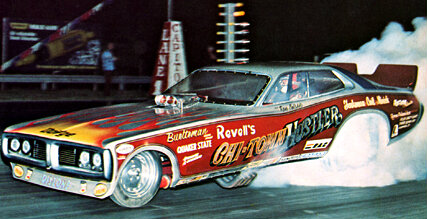 One
of the most popular floppers of the 70s was the Farkonas, Coil
& Minick "Chi-Town Hustler." Starting life as a
flip-top Cuda in 67, the team debut the now infamous Charger in
68. Considered THE killer car of the period, the Hustler typically
covered the field by 2 tenths of a second and drove fans to the
brink with it's long smoky burnouts. Drivers throughout the 70s included Clare Sanders, Ron Colson, Russell Long, Denny Savage,
Pete Williams and of course, Pat Minick. Mopar bodied until 77,
the Hustler ran a Mustang II body for a season before closing
out the decade in a more Hustler appropriate Dodge Challenger
shell. (Photo from Rislone handout, supplied by Rick Covington)
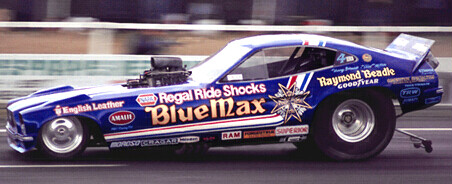 A
long way from his roots in Lubbock, Texas was Raymond Beadle and
the Blue Max Mustang pictured at Santa Pod Raceway in England
in the mid/late 70s. Beadle opened the 70s driving T/F cars in
TX, then shoed one of Don Schumacher's Cudas in 73/74. Beadle
teamed up with Blue Max "founder" Harry Schmidt (who
had parked the Max in 74 for financial reasons) in 75. The team
stayed together through 76 when Beadle bought Schmidt out and
took full control of the Blue Max operation. Max won Indy in 75,
the IHRA World Championship in 75, 76 and broke Prudhomme's stranglehold
on NHRA competition by winning the NHRA title in 79. In 78 a yellow
and blue Arrow body replaced the Mustang II body; Mopar shell
took the Max name into the 80s. (Photo by Nick)
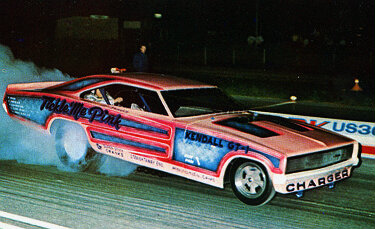 PA
based Al Graeber's "Tickle Me Pink" Charger ran mainly
in the NE from 68-73. Chassis was built by Graeber who ran a small
chassis shop that also turned out cars in the early 70s such
as JJ's 71 Camaro. This car was unique in that rather having a
flip up body, the entire nose came off the car (from forward of
the K in Kendall) and the roof flipped up. In the mid-70s Graeber
turned his attention to circle track racing. Rumor has it this
car still exists somewhere in the mid-west... possibly being restored
for nostalgia racing? (Photo from Tickle Me Pink handout courtesy
of Jim White)

Descended
from the popular Beebe & Mulligan T/F entry of the late 60s
came Tim Beebe's Fighting Irish Satellite, 1972. Preceded by a Ramchargers powered Camaro driven by Ron O'Donnell, this car was
handled by Dick Rosberg. Rosberg's background included time in
nitro drag boats in the late 60s, So Cal T/F cars in the early
70s before being asked by Beebe to shoe the Fighting Irish entry.
At the end of 73 Beebe sold the car and Rosberg moved on to drive
the last Ramchargers flopper in 74. Rosberg closed out the 70s
driving his own Fighting Irish Trans Am (with Beebe's blessing
to use the name). Car was competitive as demonstrated by Rosberg's
runner up finish in Div 3 flopper points in 78. (Photo courtesy
of James Morgan)
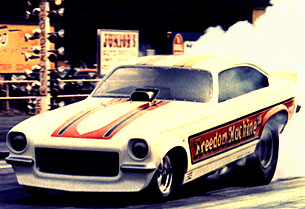
The
Freedom Machine Too Vega made it's debut at the beginning of the
1972 season in New England. Owned by Charlie Siegars and John
Corcoran, car was powered by 392 Chrysler supplied by Tom Dawes
of Freedom Machine Top Fuel Dragster fame and driven by Don Roberts.
Car was built strictly as a match race car and would run 6.70s
at 215- 220 mph. Car ran from 1972 'til 1975. Then Siegars and
Corcoran sold it and bought Tom Ivo's rear engine dragster for
the 1976 season and called it the Sundowners. Today
Charlie Siegars
is one of the guys responsible for building Jeff Gordon's World
Championship winning NASCAR motors. (Photo, info courtesy of Don
Roberts)
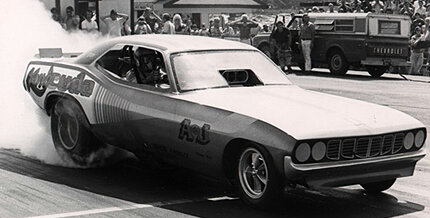 And
speaking of Jeff Gordon (no, not THAT Jeff Gordon!)... Jeff Gordon's
"King Cuda" came from Newton, Mass. In Don Roberts words
Gordon was "A nice kid with a small amount of money from
his folks... he wanted a funny car in the worst way... "
King Cuda was built in 1970 and made it's debut in the spring
of 1971.The
chassis was state of the art Logghe Bros and car was motivated
by a Chrysler 426 with Lenco transmission. Roberts made the first
shakedown passes at Oxford, ME, and Epping in the car before turning
over the reins to Gordon. Car could run 6.90-7.00's at 205-210.
Gordon drove the Cuda from 1971 to 1974. The car was called the
King Cuda for a period, name was later changed to the Bostonian
and injectors replaced the supercharger, and later Bostonian Charger
with a blower was campaigned. Sam Miller did a stint in the car
in 74 when the Charger burned to the ground. (Info, Photo courtesy
of Don Roberts by Paul Wasilewski Jr.)
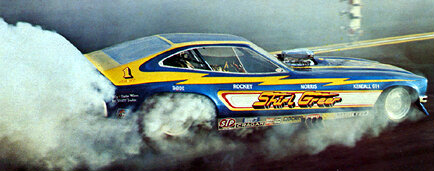 From
Warner Robbins, GA came the first "real" NHRA World
Champ, Shirl Greer, circa 1975 (note the #1 on the car). Greer
won the 74 title with his "Chained Lightning" Mustang
after the first season long points chase (as opposed to a single
race for the title). A near catastrophic fire during qualifying
for the Finals at Ontario nearly ended his chances, but a total
rebuild by Greer and an army of friends got Greer through the
1st round where he secured enough points to capture the championship
(and burned the car down again). Greer was a perennial Div 2 contender
and won the division F/C title in 76, 77 and 78. Trivia fodder:
Greer was the first driver to reset the NHRA flopper record in
the decade of the 70s with a 7.30 in his "Tension" mini-Charger
which erased Danny Ongais' 7.37 mark in M/T's Mustang from 69.
(Photo from Kendall handout courtesy of Rick Covington)
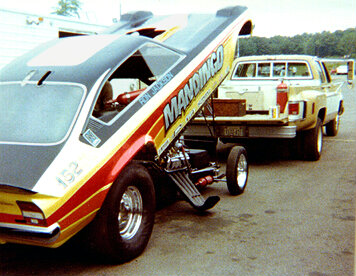 From
1976 and Washington D.C. came the "Mandingo" Vega of
the Jackson Bros (Tyrone & Ron) which was named for the popular
literary slave who gained recognition as an invincible fighter.
Ushering in the 70s with an ex-Bob Banning Charger, by 73 the
brothers had their first new race car in the form of the Woody
Gilmore built "High Explosive" Vega. The car was upgraded
in 76 with a new body and tin supplied by S&W Race Cars, paint
scheme designed by Kenny Youngblood and sprayed by Circus. Biggest
event win came at the 75 Suffolk "Little Guy Nationals."
Bill Barrett of "Black Magic" fame wrenched the Mandingo
entry. In 77 the Jacksons sold their entire operation, buyer unknown.
(Photo courtesy of James Morgan)
 New
Jersey's "Crazy Jake" Crimmins Mustang II pictured at
Lebanon Valley, NY in 79. Crimmins opened the decade driving the
"Raceway Speed Center" injected Maverick, did a stint
driving the Swenson & Lani Mustang in 72, drove and toured
with one of Jungle's cars in the mid-70s before moving on to
shoe his own "Crazy Jake" flopper. Car was Division
1 regular, winning both the 78 and 79 division opening WWCS events,
but mid-season 79 Crimmins sold his entire operation and went
looking for a "ride." Crimmins briefly drove the "Shady
Glenn" Plymouth flopper when seat was vacated by Jim Adolph
at end of 79. (Photo courtesy of Dave Milcarek)
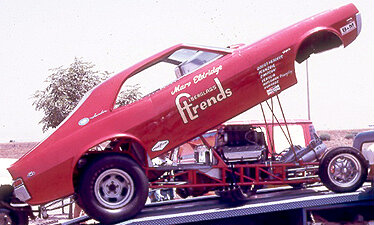 Marv Eldridge's
Javelin was one of a trio of F/C's run out of the Fiberglass
Trends shop in 69-70. Eldridge also had a topless Corvette (which
mirrored the paint scheme on this Javelin and was a charter member
of the Coke Cavalcade circuit), a white Challenger and this car.
Not a common body style, other Javelin bodied floppers included
the Doug's Headers red, white and blue rear engine "Javelin
1" of the late 60s, the more conventional "Javelin 2",
Gary Reed's "Nutcracker", Bob Pickett's "Mr. Pickett"
and the "Travelin'' Javelin" from So Cal. None were terribly
successful. (Photo courtesy of Drag Racing Memories.)
 Needing
no introduction to new millennium flopper fans is John "Brute"
Force. Force's first flopper was Jack Chrisman's sidewinder Mustang
flopper in 73 which got John banned from OCIR for the car throwing
too many chains (and the hazards that presented!). In 75 Force
bought cousin Gene Beaver's "LA Hooker" Vega and in
76 Force turned to F/C racing full time. With Steve Plueger wrenching
and backing from Leo's Stereo, 78 was the "turn around"
year for Force. He won OCIR's PDA meet and a couple flopper shows
at Fremont. Force hit the NHRA trail full time in 79, and was
rewarded with his first final round appearance at the 79 Cajun
Nationals where he lost to Kenny Bernstein. The rest... is history!!!!
(Photo by John Shanks, used with permission.)
 Descended
from the popular long line of Malcolm Durham's Washington DC based
Strip Blazer Chevys that terrorized eastern tracks in the 60s
came this Lee Jones driven entry from 1975. Jones was driving
his own "Jet Age Special" Camaro floppers on the west
coast when he teamed up with Durham to drive this #2 Strip Blazer,
a Sarte built ex-Jeg Coughlin car previously campaigned by Dale
Emery as a AA/FC and Jeg as an alcohol car. As a team driver for
Durham, Jones chauffeured Strip Blazer entries on both the east
and west coasts while Durham concentrated on the east with a Pro
Stock Vega. (Photo from the Bob Plumer Collection)
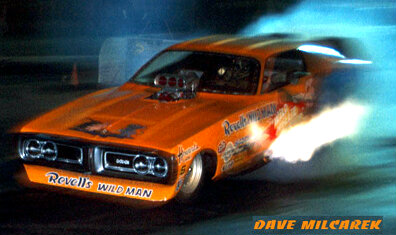 From
1973 comes ex-AA/FA hero Wild Willie Borsch. Borsch made the switch
to floppers in the early 70s with this Chevy powered Dodge Charger
bodied car sponsored by Revell. Unique feature on the car, besides
the Rat powerplant, was a fake firesuited and gloved arm attached
to the left interior tinwork and window ledge as Borsch capitalized
on his "one armed" nickname gained for his altered driving
style. Chevy power gave way to Donovan power in 74 and by 76 Borsch
had moved to Florida and was running the seldom seen ex-Black
Stang of Pee Wee Wallace. He campaigned the car in Div 2 and toured
that year, then stepped briefly into the cockpit of Walt Knoch's
"Walt's Puffer" Monza after the 'Stang burned at a WWCS
event at US 131 in May 76. (Photo by Rob Potter)
[ Back ] [ Home ] [ Next ]
|
